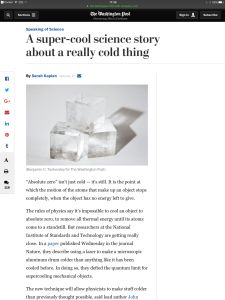
A Super-Cool Science Story About a Really Cold Thing
Recommendation
Sarah Kaplan, science reporter at The Washington Post, takes you inside the world of atoms, in which everything is moving. Tiny particles move unpredictably but constantly – as long as the temperature is above absolute zero. Kaplan presents the fascinating findings of a research group at The National Institute of Standards and Technology in Colorado, who set out to achieve the impossible: To cool a solid object down to near absolute zero. Their research may pave the way for a new class of instruments with unprecedented sensitivity and help physicists understand quantum mechanics. getAbstract recommends this article to anyone interested in fundamental research and advances in applied sciences.
Summary
About the Author
Sarah Kaplan is a science reporter at The Washington Post.








Comment on this summary